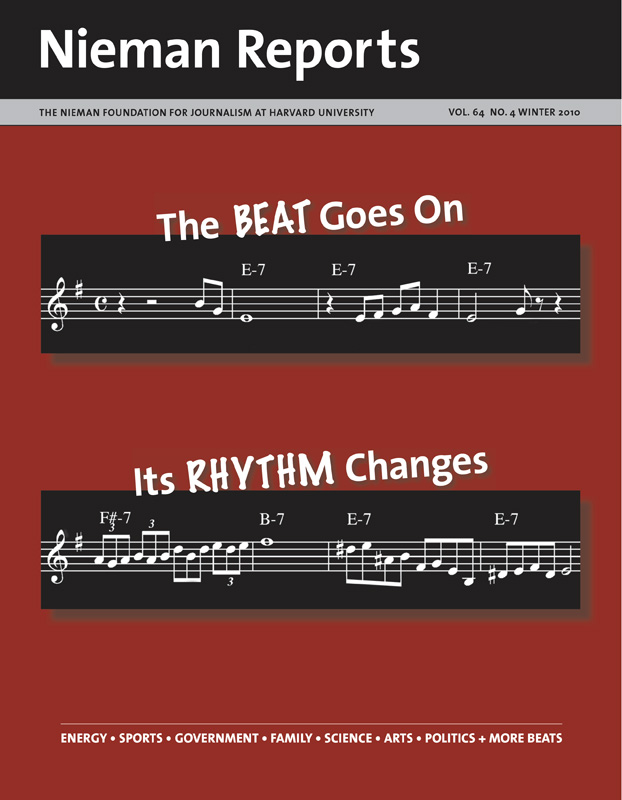When I arrived at Lippmann House in early August 2000 to begin my tenure as curator, I had only an inkling of the sweeping changes that would wash over journalism and mainstream news organizations during the coming decade.
My predecessor, Bill Kovach, in announcing his retirement, had a clearer picture of what the Nieman Foundation needed: a leader who was closer to the technological revolution sweeping the profession because of the Internet.
Instead of a curator with a Web 1.0 grasp of the new digital world at that moment, Harvard hired a man who was, at best, a Web 0.0. Ten years later, as I prepare to retire in June, the foundation has a respected voice in the vibrant conversations about the future of journalism. Its online presence has built a large and growing audience while enriching the experience of Nieman Fellows.
In my last years as a newspaper editor, I understood that an emerging culture of innovation and experimentation would reshape journalism. I pushed my staff at The Detroit News to launch detnews.com in 1995. I couldn’t tell you how they did it, but I loved what my role as editor empowered me to do: Hire talented people, give them freedom to carry out their responsibilities, encourage creativity, and enable them to bring the best ideas to life.
Meeting with the Nieman staff on that first day, I recognized that change wouldn’t come quickly but that new thinking had to begin. Nieman Reports existed on the foundation’s website, though in rudimentary form. Through the years, the magazine’s digital footprint has grown considerably—with slideshows, audio and curated links supplementing its content—and its global audience continues to expand via social media. Editor Melissa Ludtke, NF ’92, and her staff serve journalism educators through Professor’s Corner, where original content is paired online with stories from the magazine for use by faculty and students.
The first major innovation was establishing the Nieman Narrative Journalism Program. Mark Kramer came from Boston University in 2001 to build an annual conference that drew many hundreds and associated the Nieman Foundation with the best in journalistic storytelling. His successor, Constance Hale, brought the narrative experience onto the foundation’s website, and when financial cutbacks in 2009 forced us to suspend the conference, Andrea Pitzer, an ’08 affiliate, stepped in to create Nieman Storyboard, which sustains the foundation’s presence in the world of narrative.
In 2004, Barry Sussman, who edited coverage of Watergate at The Washington Post, joined us to create the Nieman Watchdog Project. It strengthens reporters’ ability to ask insightful questions by publishing essays by experts with a deep knowledge of pertinent issues—a process similar to the learning experience of Nieman Fellows in Harvard’s classrooms.
In the fall of 2007, I told the Nieman Foundation Advisory Board that it was important for the foundation to find its place in the critical discussions about how technology was changing journalism. We spent a year investigating the idea before deciding to launch a project that became the Nieman Journalism Lab. Joshua Benton, who was just completing his Nieman year, was hired as director. Through a mixture of original reporting and research, analysis and commentary, and the input of a vibrant community of innovators and thinkers, the lab has become a core resource for those who are trying to figure out how quality journalism can thrive and survive in the Internet age. By its second anniversary this October, the lab had generated 2.4 million page views.
The expansion of Walter Lippmann House in 2003 enabled the foundation to introduce an era of Nieman conferences. Fellows meet for seminars with policymakers, scholars and other journalists in this enlarged space, which is where we host dinners, soundings, workshops and conferences. In her role as special projects manager, Stefanie Friedhoff, NF ’01, organizes a range of events for fellows, the Harvard community, and targeted audiences where reporters and potential sources meet in an environment that lessens tensions and misunderstandings and where they are exposed to authoritative knowledge and fresh ideas.
The Nieman Foundation’s capacity for change and growth has been supported by a solid financial base built on an endowment that has grown substantially as part of the university’s investment portfolio. Over the past decade, the foundation itself has raised $9 million from grant givers to underwrite fellowships and programs and from friends and alumni whose gifts helped pay off the investment in enlarging and renovating Lippmann House.
I have come to deeply appreciate two of the Nieman Foundation’s many blessings: its special role as an independent part of a university community that is welcoming to its fellows and a universe of journalists around the world proud to say they are Nieman Fellows.



